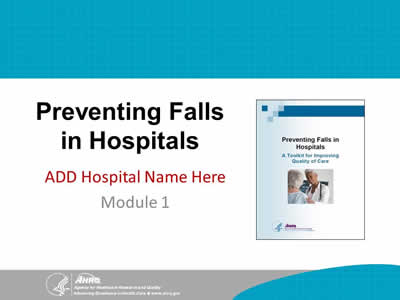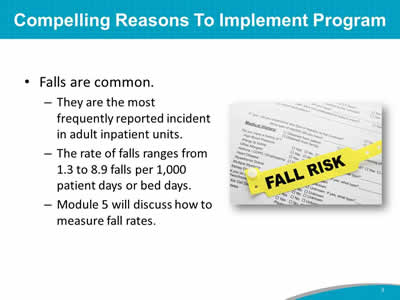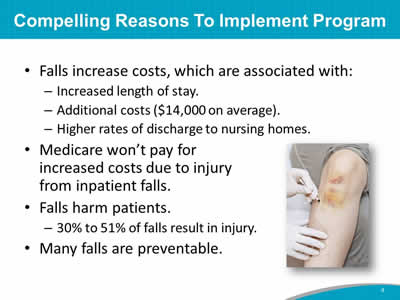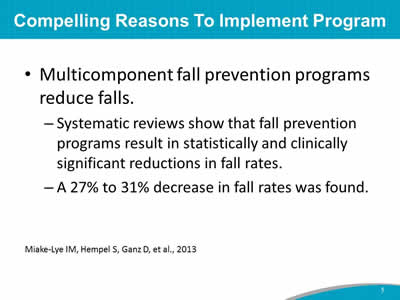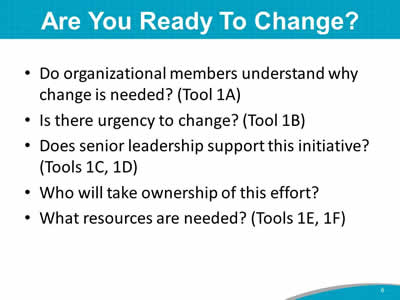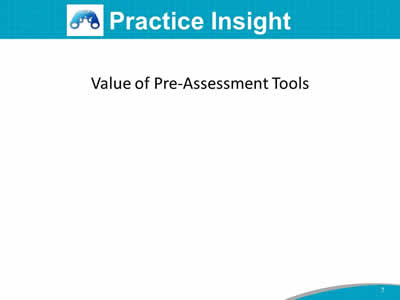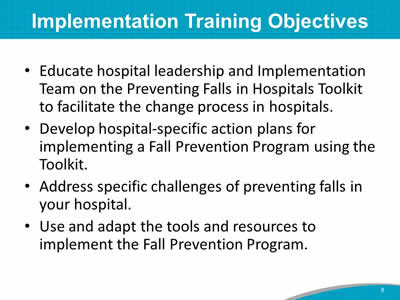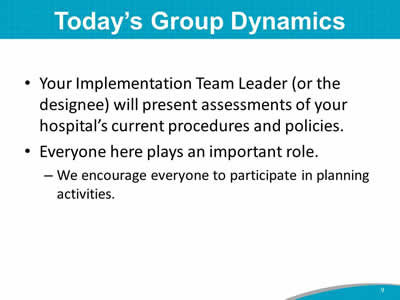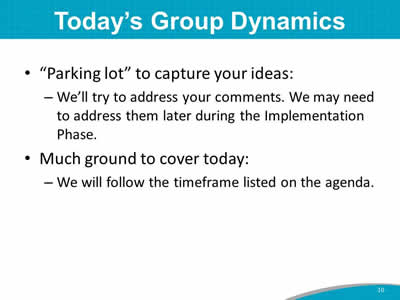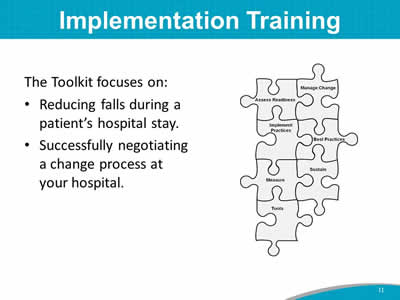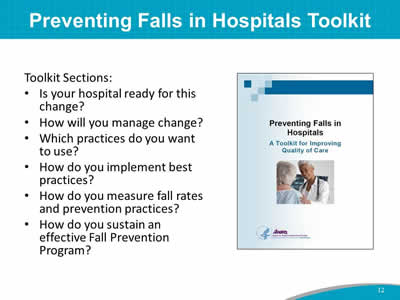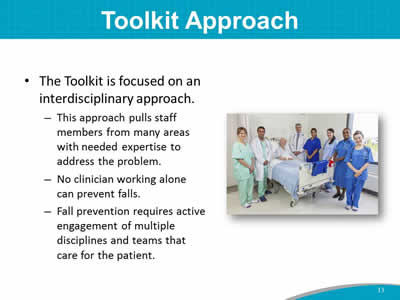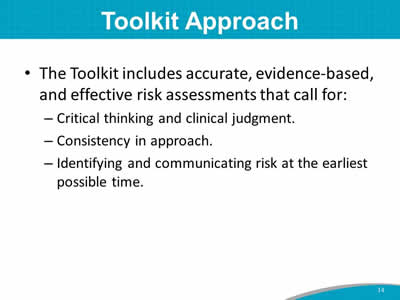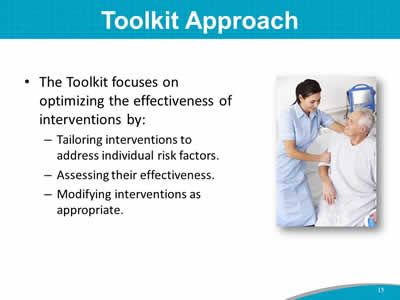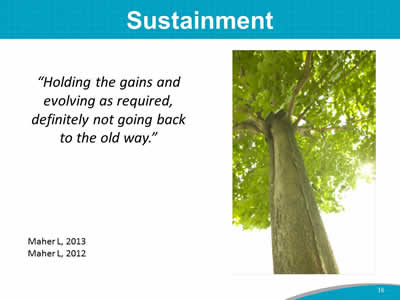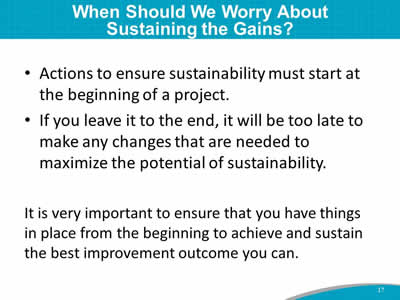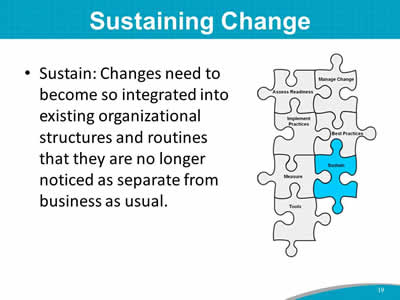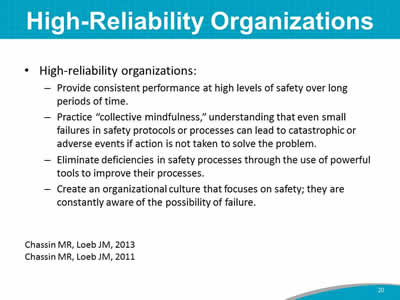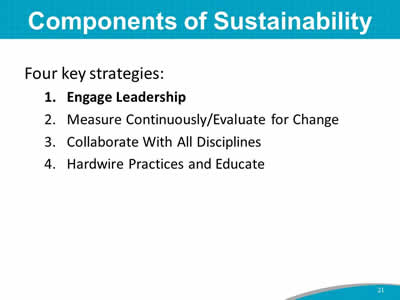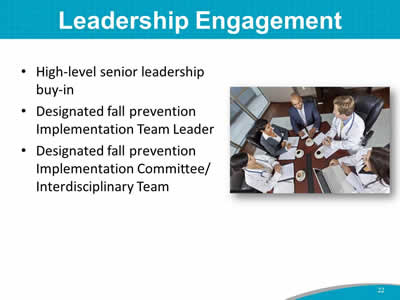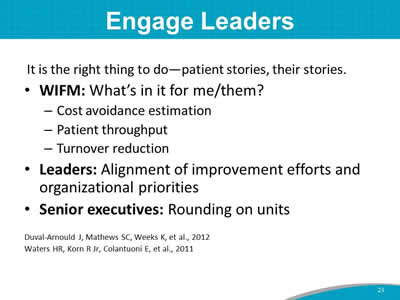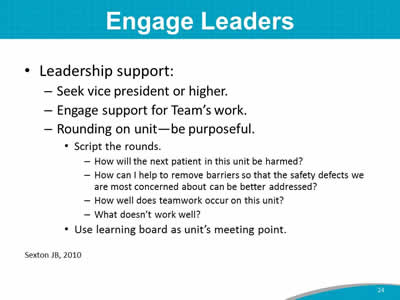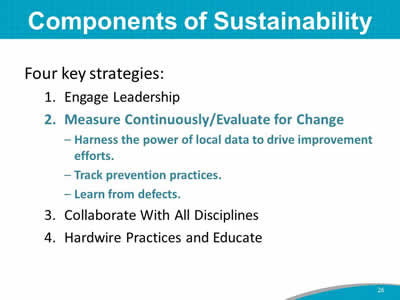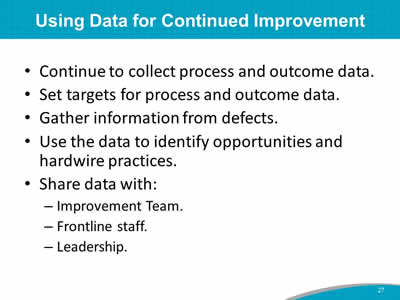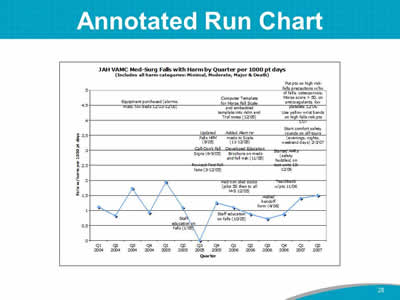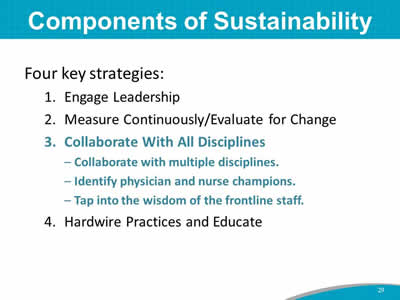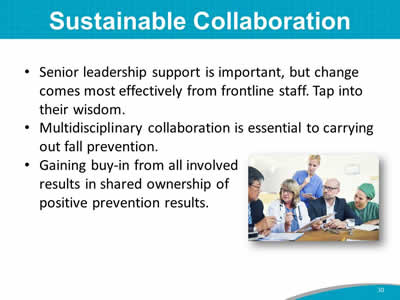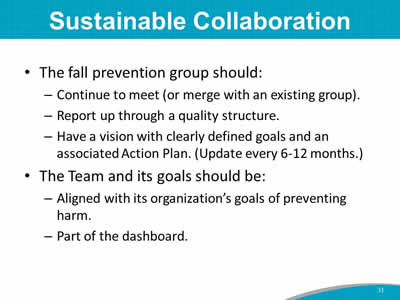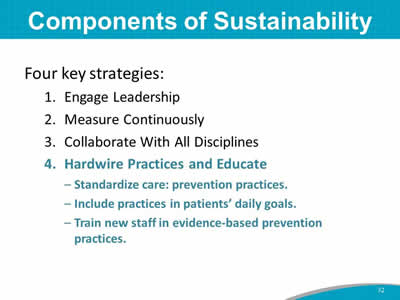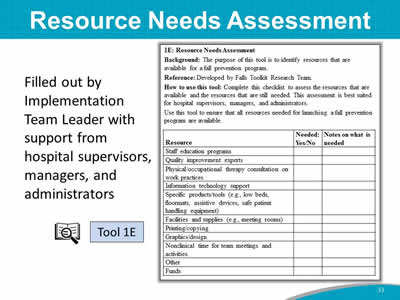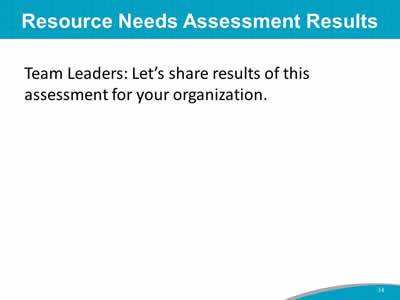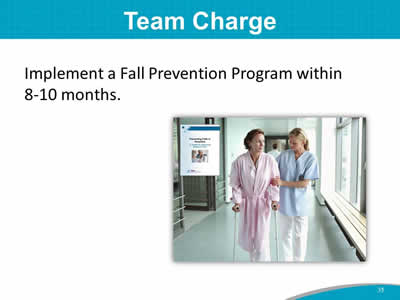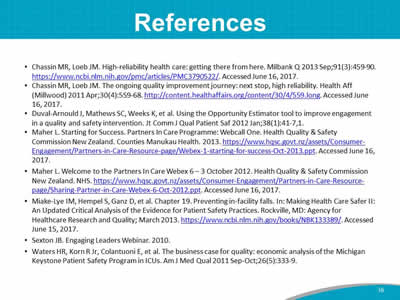Module 1: Preventing Falls in Hospitals—Training Guide
Module Aim
The aim of this module is to introduce the Preventing Falls in Hospitals Toolkit training.
Module Goals
The goals of this introductory module are to identify the overall objectives of the training, discuss key components of sustainment, describe the Toolkit, discuss why a hospital would be interested in decreasing fall rates, and complete the Resource Needs Assessment.
Timing
This module will take 45 minutes to present.
Allow 30 minutes to present slides 1–32. That leaves 10–15 minutes to discuss the findings of the Resource Needs Assessment (slides 33–35).
Learning Methodology Checklist
- Large group discussion.
- PowerPoint slide presentation.
Materials Checklist
- LCD projector and laptop.
- "Parking lot" flip chart (with tape or sticky band) and markers.
Additional Related Training Resources
- Sustainment—AHRQ Fall Prevention Program Implementation Sharing Webinar.
Instructor Preparation
- Alert the organizational leader (or other appropriate individual) to share what led the organization to conduct this fall prevention initiative and how senior leadership plans to support this initiative. Consider developing a project charter to kick off the project. A project charter template can be found at: https://www.ahrq.gov/sites/default/files/wysiwyg/professionals/systems/hospital/qitoolkit/d2-projectcharter.pdf.
- Alert the Implementation Team Leader to be ready to present and discuss the completed Resource Needs Assessment (Tool 1E) in Module 1. Have the Team Leader make copies of the completed Needs Assessment for each participant, or use the laptop to show the completed Needs Assessment on the screen.
- Add the specific hospital name to the first slide.
- Make sure to have the PowerPoint file Module 1 cued on the computer and minimized.
- Have a copy of the following for all participants:
- Module 1 PowerPoint slide presentation handout, 3 slides to a page.
- Miake-Lye IM, Hempel S, Ganz D, et al. Chapter 19. Preventing in-facility falls. In: Making Health Care Safer II: An Updated Critical Analysis of the Evidence for Patient Safety Practices. Rockville, MD: Agency for Healthcare Research and Quality; March 2013. https://archive.ahrq.gov/research/findings/evidence-based-reports/ptsafetyIIchap19.pdf
- Tool 1E: Resource Needs Assessment (completed by the Implementation Team Leader).
Module 1: Preventing Falls in Hospitals
| Slide | Script |
|---|---|
|
Slide 1
|
Say: Welcome to the training on the Preventing Falls in Hospitals Toolkit. By now, you should have a copy of the Toolkit in hand. If you have not done so, please read through the Toolkit. This training will focus on incorporating the wealth of information and strategies from the Toolkit as you plan your Fall Prevention Program. My name is (your name), and I will be leading the training today. The purpose of this training is to help you overcome the challenges associated with developing, implementing, and sustaining a Fall Prevention Program with the tools and resources from the Toolkit. |
| Slide 2
|
Say: I’d like to get to know each of you a little more by doing a fun ice breaker.
Please introduce yourself by stating:
Let’s start with the person to my left. Instructor’s Note: If you wish, you may also ask participants to briefly describe a lesson they have learned about patients or family members who have experienced a fall. |
| Slide 3
|
Say: There are many reasons to implement a Fall Prevention Program at a hospital.
Falls are common. They are the most frequently reported incident in adult inpatient units. The rate of falls in U.S. acute-care hospitals ranges from 1.3 to 8.9 falls per 1,000 patient days or bed days. This rate translates to more than 1,000 falls per year in a large facility. Higher fall rates are reported in particular units, such as rehabilitation, geriatrics, and neurology. Because falls are believed to be underreported, most estimates are assumed to be conservative. Instructor’s Note: Please see references below. Miake-Lye IM, Hempel S, Ganz D, et al. Chapter 19. Preventing in-facility falls. In: Making Health Care Safer II: An Updated Critical Analysis of the Evidence for Patient Safety Practices. Rockville, MD: Agency for Healthcare Research and Quality; March 2013. |
| Slide 4
|
Say: There is a business case for fall prevention. Falls are associated with increased length of stay, higher rates of discharge to nursing homes, and greater health care utilization.
In one study, a fall with serious injury added 6.3 days to the hospital stay. The average operational cost for a fall with injury is about $14,000. Medicare no longer reimburses hospitals for increased costs due to injury from an inpatient fall. More importantly, falls harm patients. Between 30 and 51 percent of falls in hospitals result in an injury ranging from bruises to severe wounds or bone fractures. Some falls even result in permanent injury or death. Lastly, many falls are preventable. Instructor’s Note: Please see references below. Haines TP, Hill AM, Hill KD, et al. Cost effectiveness of patient education for the prevention of falls in hospital: economic evaluation from a randomized controlled trial. BMC Med 2013 May 22;11:135. Miake-Lye IM, Hempel S, Ganz D, et al. Chapter 19. Preventing in-facility falls. In: Making Health Care Safer II: An Updated Critical Analysis of the Evidence for Patient Safety Practices. Rockville, MD: Agency for Healthcare Research and Quality; March 2013. Wong CA, Recktenwald AJ, Jones ML, et al. The cost of serious fall-related injuries at three Midwestern hospitals. Jt Comm J Qual Patient Saf 2011 Feb;37(2):81-7. |
| Slide 5
|
Say: Three systematic reviews of multicomponent in-facility Fall Prevention Programs were assessed in a 2011 AHRQ evidence report.
These reviews revealed that Fall Prevention Programs result in statistically and clinically significant reductions in fall rates. The reviews showed a 27 to 31 percent decrease in the rate of falling. The Fall Prevention Program you are implementing is a multicomponent program. In fact, in a pilot study of the implementation of the AHRQ Fall Prevention Program that included 10 varied hospitals across the country and this specific training program, participating hospitals reduced their fall rates and injury fall rates by comparable amounts. Instructor’s Note: Please see references below. Miake-Lye IM, Hempel S, Ganz D, et al. Chapter 19. Preventing in-facility falls. In: Making Health Care Safer II: An Updated Critical Analysis of the Evidence for Patient Safety Practices. March 2013. Agency for Healthcare Research and Quality, Rockville, MD. |
| Slide 6
|
Say: Several tools in Section 1 of the Toolkit will help a hospital determine how ready it is to change and to implement a Fall Prevention Program. Tools 1A, 1B, 1C, 1D, 1E, and 1F are designed to assess readiness.
These readiness assessment tools were completed by the Team Leader(s) in concert with hospital leadership. Do: Ask the organizational senior leader (or other appropriate individual) to share what led the organization to conduct this fall prevention initiative and how senior leadership plans to support this initiative. If you have a project charter, share it with the group at this time. Say: Thank you (name) for sharing the hospital leadership perspective on this important prevention initiative. These assessment tools are among the many assessment tools in the Toolkit used to determine opportunities for change. |
| Slide 7
|
Say: One hospital from the AHRQ pilot study realized the value of using the pre-assessment tools from the Toolkit. The first thing this hospital’s Implementation Team did as a group was add monthly meetings with the Chief Nurse Officer, or CNO, because the CNO reports monthly to the C Suite leadership.
The Team began sharing the AHRQ prevention project with the CNO and leadership—the project assessments, requirements, and change process. When they completed the pre-assessment tools with their facility, they found many opportunities for change. One of the most notable observations was that they did so much education for nursing, but almost none for other department staff, such as radiology, transporters, and so many other people who touch the patient. As a result of completing the Toolkit assessment tools, the Implementation Team realized they had many unrecognized needs and shortcomings in their practices. That’s why the AHRQ assessment tools were so valuable for the hospital. When they realized the limitations, the hospital Implementation Team decided to share the assessment tools with all the other prevention committees in-house. Thus, the CAUTI, SSI, and Pressure Injury committees used the AHRQ assessment tools, and a speak-up campaign was launched to trend for similar issues. These items were presented at the Quality Council to the C Suite with a plan to use all the opportunities for improvement. |
| Slide 8
|
Say: Given the need for change in your hospital, the overall objectives for this training are to:
|
| Slide 9
|
Say: Throughout the working meeting today, (name of the Implementation Team Leader or designee) will present assessments of your hospital’s current procedures and policies.
These assessments will help facilitate the change process and will help the Team make decisions and plans for implementing best practices for fall prevention. They worked hard to complete these assessments, and we appreciate the time invested. Let’s give our Team Leader, (name), and (names of others who have done the upfront work) a round of applause. Everyone in this room is important to the success of planning and implementing the Fall Prevention Program. We need everyone here to participate to the fullest in planning activities. |
| Slide 10
|
Say: We have a “parking lot” flip chart in the room to keep track of your comments and suggestions as we go through the training today. If we don’t address these comments today, we’ll address them during the Implementation Phase.
We have much to cover today. If we run short of time, we may have to put some items in the “parking lot.” |
| Slide 11
|
Say: The Toolkit focuses on reducing falls during a patient’s hospital stay and negotiating a successful change process at your hospital. Systematically working through this change process can help you overcome the challenges associated with developing (or refining), implementing, and sustaining a Fall Prevention Program. |
| Slide 12
|
Say: The Toolkit is organized under six major questions intended to be used primarily by you, the Implementation Team. You are charged with leading the effort to put the new prevention strategies into practice.
The six sections will help you answer these questions:
|
| Slide 13
|
Say: The Toolkit focuses on engaging an interdisciplinary team, including members from many areas with the expertise needed to address the problem.
No hospital professional working alone can prevent all falls. Fall prevention requires active engagement of multiple disciplines and teams involved in caring for the patient and his or her family. |
| Slide 14
|
Say: The Toolkit includes accurate, evidence-based, and effective risk assessment tools.
However, tools alone will not improve fall rates. You need to use critical thinking and practical clinical judgment—not just memorize how to conduct assessments. Consistency in approach is highlighted so everyone is following the same approach to preventing falls. Risk assessments are most effective when increased risk for a fall is identified and communicated early. |
| Slide 15
|
Say: The Toolkit focuses on helping you optimize the effectiveness of interventions.
Your Implementation Team is encouraged to tailor interventions to address individual risk factors. Assessing the effectiveness of the interventions and modifying them as appropriate supports quality improvement practices and is intended to improve fall prevention in the hospital. |
| Slide 16
|
Say: Even though sustainment is addressed in Section 6 of the Toolkit, sustainment is so important, we are going to address it right from the beginning and throughout the training modules.
What is sustainment? It is holding the gains we have achieved in fall prevention and evolving as needed with the process changes we have gained, but definitely not going back to the old ways. This is not a project that ends and we are done. The mindset is that we develop a culture of safety for our patients, and prevention processes are ongoing with the goal of continually working to keep our fall rates low. Instructor’s Note: Suggest that Team Leaders and potentially the whole team watch the Sustainment Webinar as an additional related training resource, noted in the front matter. |
| Slide 17
|
Say: A focus on sustainability must begin at the start of a project. People typically think that any consideration or action that might be needed to ensure sustainability of their improvement initiative can wait until the end of the project. We know that if you leave it to the end, it will be too late to make any changes that are needed to maximize the potential of sustainability. |
| Slide 18
|
Say: This project is an extensive journey of change to make our hospital safer for patients. All the steps in the change process need to be continued and adapted as needed to sustain our gains. The best practices, collaborations, and measurement tracking are all components that need to be sustained. |
| Slide 19
|
Say: The changes should become so integrated into existing organizational routines and structures that they are no longer noticed as separate from business as usual.
The new strategies become the norm. This is how we do it here at our hospital. This is sustainment. |
| Slide 20
|
Say: We all strive to become high-reliability organizations, where we provide consistent performance at high levels of safety over long periods of time. This is not easy, but it is doable.
Here are the three main components of high-reliability organizations:
Instructor’s Note: Please see references below. Chassin and Loeb, The Milbank Quarterly, Vol 91 No 3, 2013 pp 459-490; Chassin and Loeb. Health Affairs, April 2011. https://www.ncbi.nlm.nih.gov/pmc/articles/PMC3790522/. |
| Slide 21
|
Say: Here are the top four components of sustainability:
Engaging hospital leadership in the safety effort is number 1. |
| Slide 22
|
Say: All Fall Prevention Programs need high-level senior administrative leadership support and buy-in. Those with financial decisionmaking authority should be involved and on the Team. Lessons learned from key fall prevention initiatives show that support is needed from the top-level administration and those at the bedside.
Often, the most compelling case for prevention is the business case due to increased costs. Leadership can often help with resources and removing barriers. Having a designated Implementation Team and Team Leader encourages ownership and commitment to the fall prevention goals and ensures accountability. Having an administrative champion involved with the Implementation Team can help get things done. |
| Slide 23
|
Say: Why is leadership engagement important? If leaders don’t support what you’re doing—and if leadership doesn’t feel the value of safety and hold people accountable—you are not going to get continued long-term change.
How do you get leadership involved? One of the best ways to engage leaders is to tell patient stories of harm and to discuss what drives leadership to act. What is the benefit of safety interventions? Leaders ask, “Why should I worry about this? What’s in it for me?” Talk to them in their language. For example, in addition to decreasing overall harm to your patients, what is the cost avoidance estimation or the business case for this initiative? Will this initiative save costs over the long run? How will it affect quality scorecards? How will it help patient throughput (the effective and efficient cycling of patients through procedures, imaging, and length of stay)? An executive sponsor or leader is critical to break down barriers or to increase resources. They help solve problems and achieve desired outcomes. A key strategy in involving leadership is to invite a senior executive to round on the units with you to show them your successes and barriers to success. |
| Slide 24
|
Say: Usually you want to involve a vice president or higher to support the Team’s work. Get someone to pay attention to the good work you are doing.
Again, involving leadership in purposeful rounding on a patient care unit helps. Script the rounding that day. Ask the leader to ask frontline staff these suggested questions:
These are all important issues for a positive safety culture. If there is a learning board on this unit, use it as the meeting point. You can look at current fall metrics to see what’s working and what isn’t. |
| Slide 25
|
Say: In an acute-care hospital, the Fall Prevention Implementation Team put great emphasis on involving hospital leadership. The Director of Quality and Risk Management was named as the hospital leadership sponsor for the Fall Prevention Program. She attended and participated in the initiative training. She secured the support and resources for staff to focus on this effort, including pilot testing changes sequentially over time on various units with various staff and revising organizational processes and the electronic health record (also called an EHR). She also checked in frequently with the day-to-day project leaders. She worked with the Project Team to present on the initiative to top leadership at various times, in order to secure their ongoing commitment to the changes and the resources needed for training and to ensure sustainability. All these actions tangibly involved leadership in the patient care teams’ goal: to prevent patient falls. At the end of the Implementation Phase, the Fall Prevention Team presented to the senior hospital leaders to provide an update on their fall prevention work and to secure their ongoing support and commitment to resources. The Team covered the following topics:
|
| Slide 26
|
Say: The next key component of sustainability is continuous measurement of outcome and process data. These measures tell the story of your prevention efforts. You absolutely need to collect baseline measures. You need a starting point to track your success, and then you need to continually track fall rate outcome measures. You also need to track prevention practice process measures from the start. Are the staff making the changes we said we were going to in our Action Plan? How do we know? Track the newly redesigned practices and check to see if they are being done the right way. For example, are staff individualizing care plans according to risk factors found on risk assessment? How do we know? If you are still experiencing a high rate of falls, learn from defects in your processes. If you can’t measure it, you can’t improve it. Set up a measurement committee and determine a measurement protocol that considers these questions:
Instructor’s Note: Toolkit Section 5 and Training Module 5 cover measurement in more detail. |
| Slide 27
|
Say: Measurement continues indefinitely. Examine your regularly scheduled data collection process for outcome and process measures, to see if you are collecting data that will help your prevention efforts.
Continue to collect process and outcome data during this project and in the Sustainment Phase. Set targets for outcome and process data. Gather information from post-fall huddles to see where the process may have broken down. Gather information from your defects and use this information to identify opportunities for hardwiring practices and to identify next steps. Share your progress and barriers with frontline staff and leadership. |
| Slide 28
|
Say: As an example of how data can tell a story, this annotated run chart shows fall data over time and when prevention practices were instituted.
This chart shows that when staff education and other interventions were instituted, fall rates decreased. This shows the importance of tracking rates and interventions. |
| Slide 29
|
Say: A multidisciplinary group is needed to make changes. Include all disciplines who are involved with patient care and transfer. Include nurse champions and a physician or two on the Team. Include frontline staff members on the Team, and provide a forum for them to make suggestions for prevention. |
| Slide 30
|
Say: Senior leadership support is a prerequisite for system change, but actual change in fall rate outcomes of hospitalized patients comes most effectively from the direct patient care staff.
It is important to get essential input from stakeholders, as well as to secure support and needed resources. Hospital staff collaboration is essential to carrying out fall prevention with patients. Getting buy-in from all involved is important and helps to create shared ownership of positive prevention results. |
| Slide 31
|
Say: What are your plans to keep this prevention effort going long term? After the Action Plan for fall prevention work is in place and successful, the Fall Prevention Team will need to:
The Team continues to have goals that are aligned with the organization’s culture and goals of preventing harm. Fall prevention is positioned to be part of the dashboard. Fall prevention continues to be in front of everyone. |
| Slide 32
|
Say: Equally important for sustainability is to ensure that prevention strategies to decrease the risk of falls are hardwired into daily practice. Some of the practices, such as doing a fall risk assessment upon admission, can be hardwired into an EHR.
Use critical thinking to include best practices in patients’ daily goals. Educating new staff in evidence-based practices ensures that all staff are aware of the culture of safety at this hospital. |
| Slide 33
|
Say: Now let’s end this module by talking about resource needs. Tool 1E: Resource Needs Assessment helps to identify resource needs, such as funding, staff education programs, and information technology support. Your Implementation Team Leader completed this needs assessment tool with support from hospital supervisors, managers, and administrators. |
| Slide 34
|
Do: Ask the Team Leader to share the results of this assessment. Ask: Does your hospital have any other resource needs in addition to those highlighted in this needs assessment? Say: The Administrative Champion on your Team may be able to address these identified resource needs. |
| Slide 35
|
Say: Thank you for sharing the results of the Resource Needs Assessment. The Team charge is to implement a Fall Prevention Program within 8 to 10 months at this hospital. Ask: Are there any questions before moving on to Module 2? Say: Let’s turn now to Module 2. |
| Slide 36
|
Say: For those interested, here is the complete list of references cited in this Module. |




